Healthcare Funding Models: A Comparative Analysis of UTS Hospital Data
VerifiedAdded on 2019/10/30
|8
|1570
|197
Report
AI Summary
This report examines healthcare funding models, specifically comparing casemix and per-diem approaches using data from UTS Hospital. The analysis begins by defining these two funding models, with casemix funding being based on the activities and types of patients treated, and per-diem funding involving a fixed daily allowance. The report then details the pros and cons of each model, highlighting that casemix funding is useful for reimbursement and benchmarking, but may not suit older, more complex patient populations. Per-diem funding is easy to manage but can be less flexible. The analysis also covers how casemix funding is achieved in Australian hospitals using diagnosis-related groups (DRGs). The report analyzes UTS hospital data to visualize the relationship between patient age and length of stay, finding that older patients tend to have longer stays. The report concludes that UTS hospital should consider per-diem funding due to the nature of its patient population. The analysis is supported by cited references. This report contributes to the understanding of healthcare economics and resource management within hospital settings.
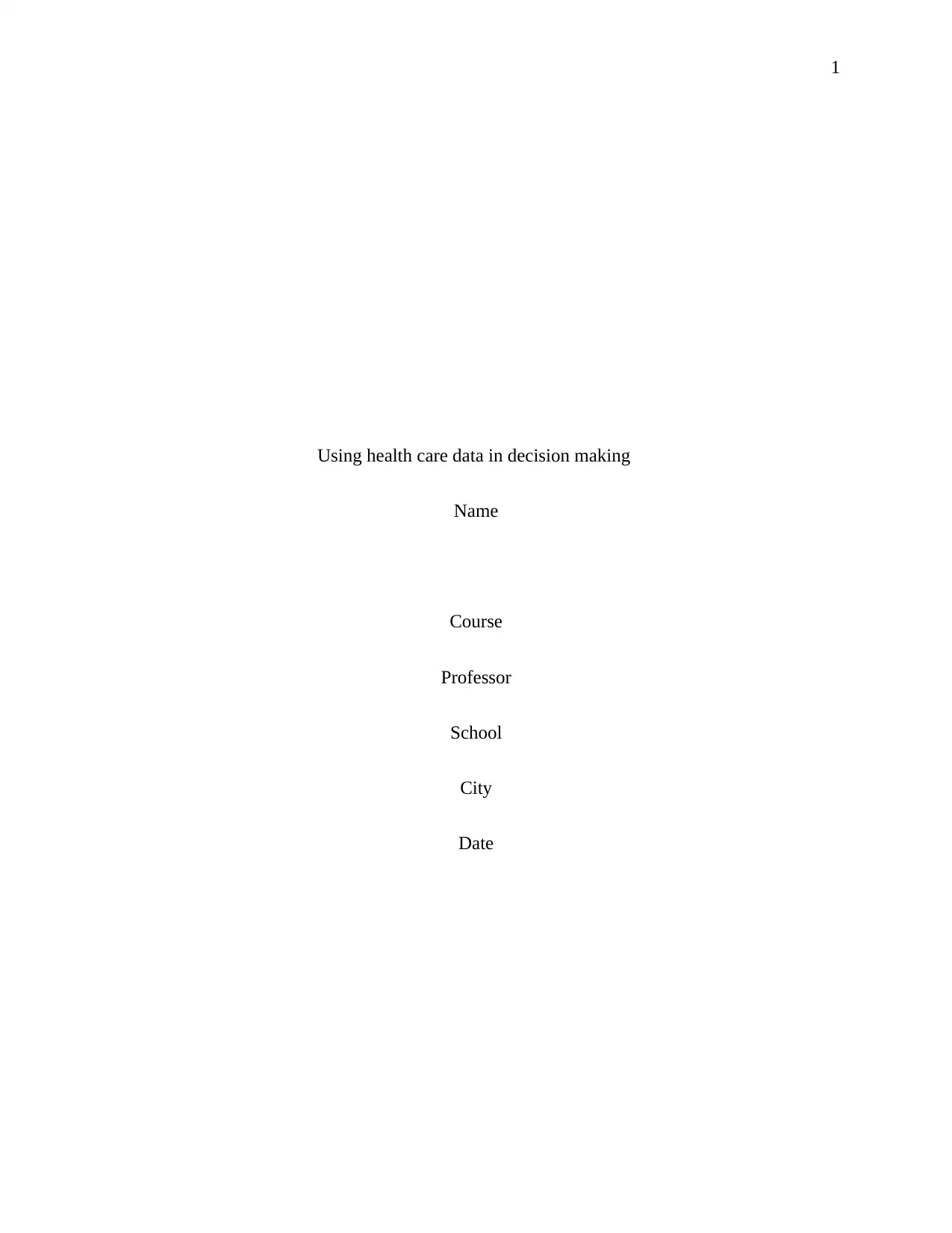
1
Using health care data in decision making
Name
Course
Professor
School
City
Date
Using health care data in decision making
Name
Course
Professor
School
City
Date
Paraphrase This Document
Need a fresh take? Get an instant paraphrase of this document with our AI Paraphraser
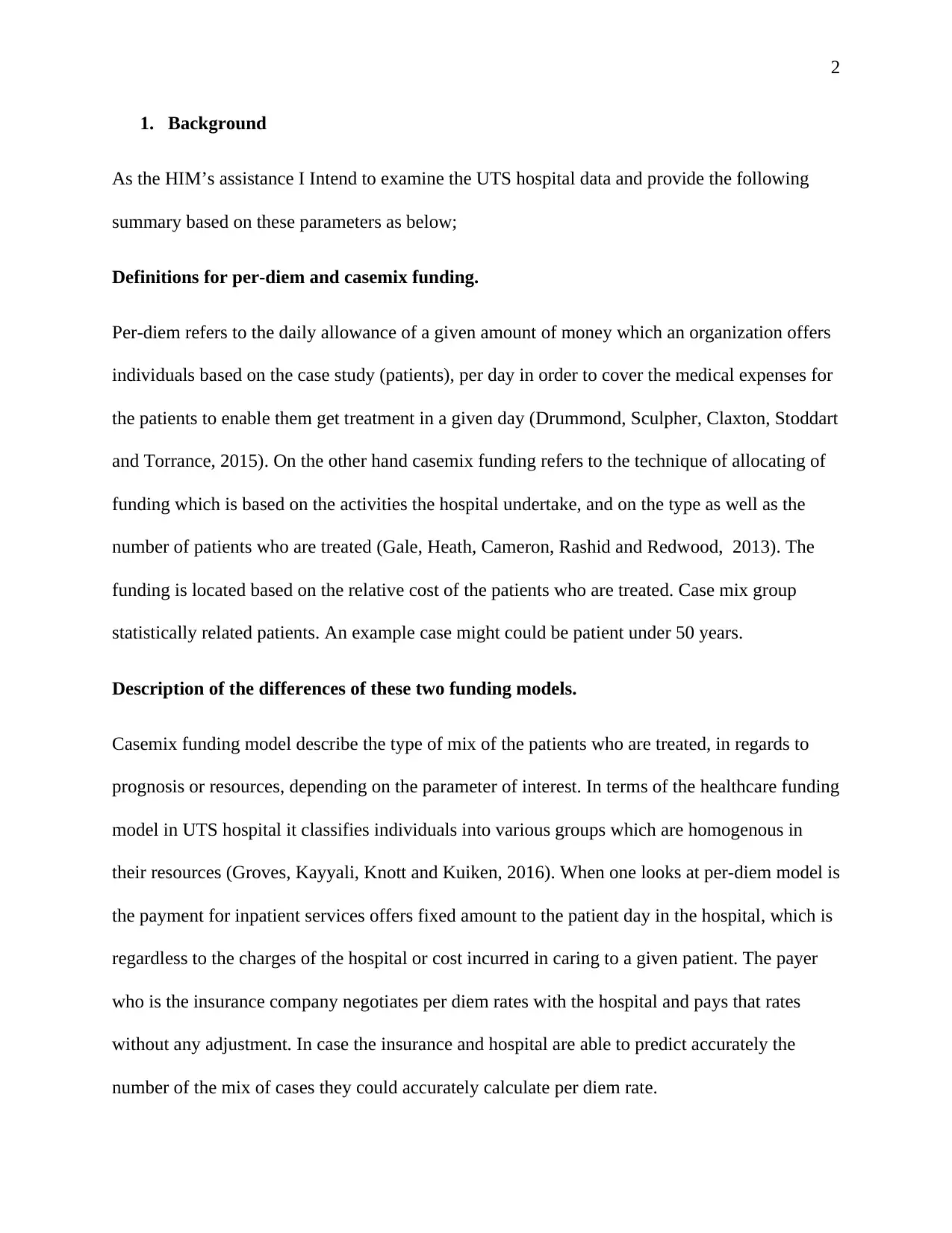
2
1. Background
As the HIM’s assistance I Intend to examine the UTS hospital data and provide the following
summary based on these parameters as below;
Definitions for per-diem and casemix funding.
Per-diem refers to the daily allowance of a given amount of money which an organization offers
individuals based on the case study (patients), per day in order to cover the medical expenses for
the patients to enable them get treatment in a given day (Drummond, Sculpher, Claxton, Stoddart
and Torrance, 2015). On the other hand casemix funding refers to the technique of allocating of
funding which is based on the activities the hospital undertake, and on the type as well as the
number of patients who are treated (Gale, Heath, Cameron, Rashid and Redwood, 2013). The
funding is located based on the relative cost of the patients who are treated. Case mix group
statistically related patients. An example case might could be patient under 50 years.
Description of the differences of these two funding models.
Casemix funding model describe the type of mix of the patients who are treated, in regards to
prognosis or resources, depending on the parameter of interest. In terms of the healthcare funding
model in UTS hospital it classifies individuals into various groups which are homogenous in
their resources (Groves, Kayyali, Knott and Kuiken, 2016). When one looks at per-diem model is
the payment for inpatient services offers fixed amount to the patient day in the hospital, which is
regardless to the charges of the hospital or cost incurred in caring to a given patient. The payer
who is the insurance company negotiates per diem rates with the hospital and pays that rates
without any adjustment. In case the insurance and hospital are able to predict accurately the
number of the mix of cases they could accurately calculate per diem rate.
1. Background
As the HIM’s assistance I Intend to examine the UTS hospital data and provide the following
summary based on these parameters as below;
Definitions for per-diem and casemix funding.
Per-diem refers to the daily allowance of a given amount of money which an organization offers
individuals based on the case study (patients), per day in order to cover the medical expenses for
the patients to enable them get treatment in a given day (Drummond, Sculpher, Claxton, Stoddart
and Torrance, 2015). On the other hand casemix funding refers to the technique of allocating of
funding which is based on the activities the hospital undertake, and on the type as well as the
number of patients who are treated (Gale, Heath, Cameron, Rashid and Redwood, 2013). The
funding is located based on the relative cost of the patients who are treated. Case mix group
statistically related patients. An example case might could be patient under 50 years.
Description of the differences of these two funding models.
Casemix funding model describe the type of mix of the patients who are treated, in regards to
prognosis or resources, depending on the parameter of interest. In terms of the healthcare funding
model in UTS hospital it classifies individuals into various groups which are homogenous in
their resources (Groves, Kayyali, Knott and Kuiken, 2016). When one looks at per-diem model is
the payment for inpatient services offers fixed amount to the patient day in the hospital, which is
regardless to the charges of the hospital or cost incurred in caring to a given patient. The payer
who is the insurance company negotiates per diem rates with the hospital and pays that rates
without any adjustment. In case the insurance and hospital are able to predict accurately the
number of the mix of cases they could accurately calculate per diem rate.
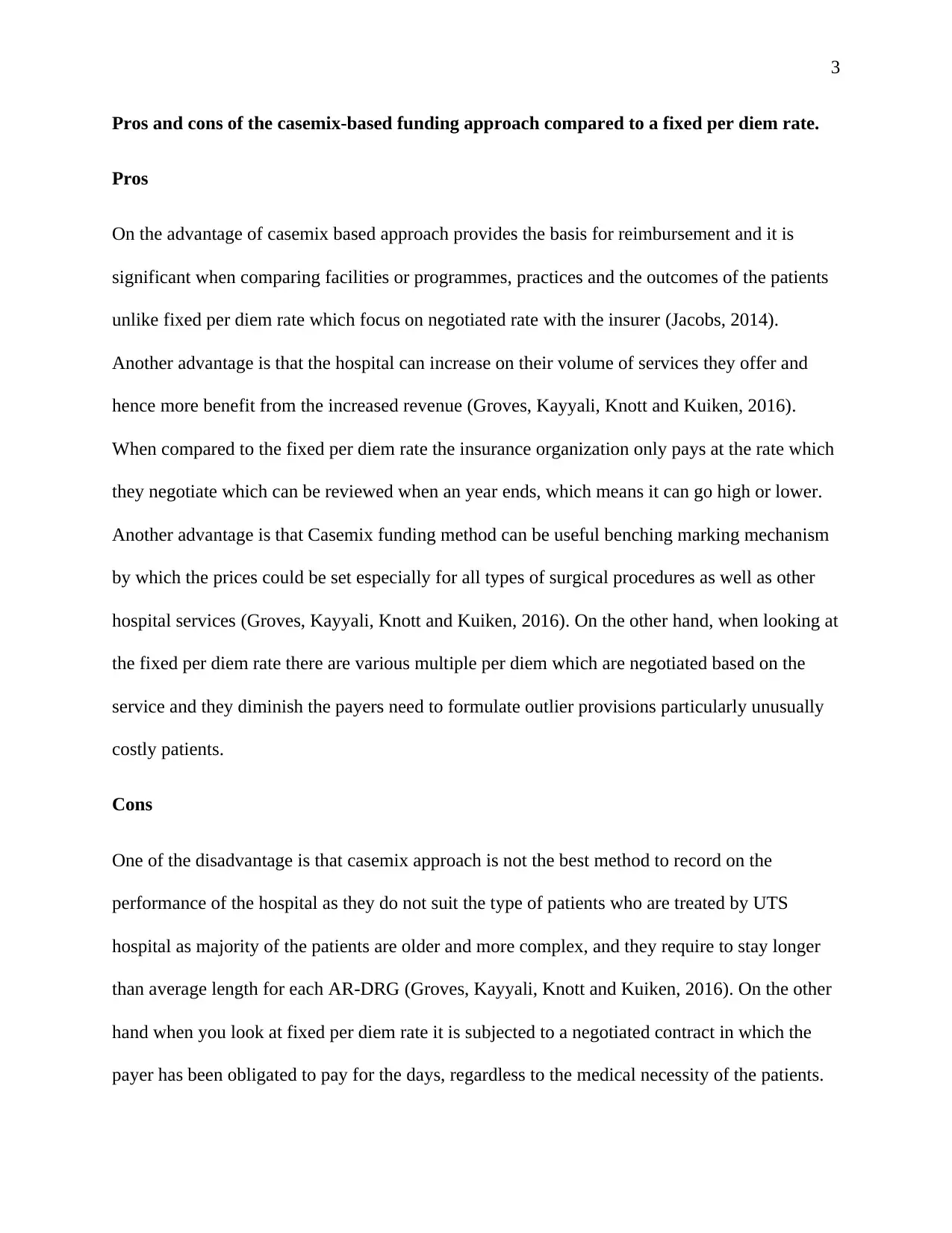
3
Pros and cons of the casemix-based funding approach compared to a fixed per diem rate.
Pros
On the advantage of casemix based approach provides the basis for reimbursement and it is
significant when comparing facilities or programmes, practices and the outcomes of the patients
unlike fixed per diem rate which focus on negotiated rate with the insurer (Jacobs, 2014).
Another advantage is that the hospital can increase on their volume of services they offer and
hence more benefit from the increased revenue (Groves, Kayyali, Knott and Kuiken, 2016).
When compared to the fixed per diem rate the insurance organization only pays at the rate which
they negotiate which can be reviewed when an year ends, which means it can go high or lower.
Another advantage is that Casemix funding method can be useful benching marking mechanism
by which the prices could be set especially for all types of surgical procedures as well as other
hospital services (Groves, Kayyali, Knott and Kuiken, 2016). On the other hand, when looking at
the fixed per diem rate there are various multiple per diem which are negotiated based on the
service and they diminish the payers need to formulate outlier provisions particularly unusually
costly patients.
Cons
One of the disadvantage is that casemix approach is not the best method to record on the
performance of the hospital as they do not suit the type of patients who are treated by UTS
hospital as majority of the patients are older and more complex, and they require to stay longer
than average length for each AR-DRG (Groves, Kayyali, Knott and Kuiken, 2016). On the other
hand when you look at fixed per diem rate it is subjected to a negotiated contract in which the
payer has been obligated to pay for the days, regardless to the medical necessity of the patients.
Pros and cons of the casemix-based funding approach compared to a fixed per diem rate.
Pros
On the advantage of casemix based approach provides the basis for reimbursement and it is
significant when comparing facilities or programmes, practices and the outcomes of the patients
unlike fixed per diem rate which focus on negotiated rate with the insurer (Jacobs, 2014).
Another advantage is that the hospital can increase on their volume of services they offer and
hence more benefit from the increased revenue (Groves, Kayyali, Knott and Kuiken, 2016).
When compared to the fixed per diem rate the insurance organization only pays at the rate which
they negotiate which can be reviewed when an year ends, which means it can go high or lower.
Another advantage is that Casemix funding method can be useful benching marking mechanism
by which the prices could be set especially for all types of surgical procedures as well as other
hospital services (Groves, Kayyali, Knott and Kuiken, 2016). On the other hand, when looking at
the fixed per diem rate there are various multiple per diem which are negotiated based on the
service and they diminish the payers need to formulate outlier provisions particularly unusually
costly patients.
Cons
One of the disadvantage is that casemix approach is not the best method to record on the
performance of the hospital as they do not suit the type of patients who are treated by UTS
hospital as majority of the patients are older and more complex, and they require to stay longer
than average length for each AR-DRG (Groves, Kayyali, Knott and Kuiken, 2016). On the other
hand when you look at fixed per diem rate it is subjected to a negotiated contract in which the
payer has been obligated to pay for the days, regardless to the medical necessity of the patients.
⊘ This is a preview!⊘
Do you want full access?
Subscribe today to unlock all pages.

Trusted by 1+ million students worldwide
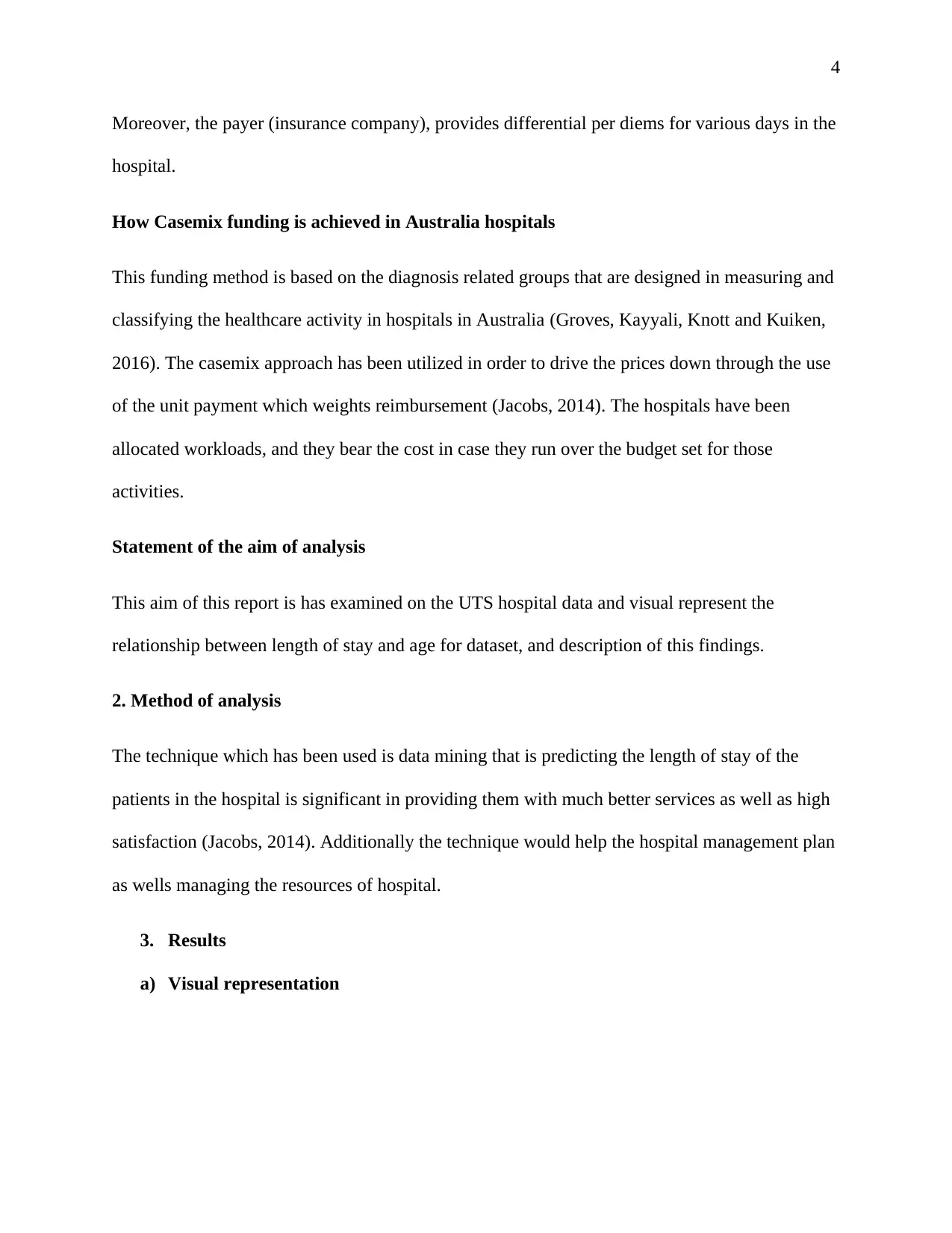
4
Moreover, the payer (insurance company), provides differential per diems for various days in the
hospital.
How Casemix funding is achieved in Australia hospitals
This funding method is based on the diagnosis related groups that are designed in measuring and
classifying the healthcare activity in hospitals in Australia (Groves, Kayyali, Knott and Kuiken,
2016). The casemix approach has been utilized in order to drive the prices down through the use
of the unit payment which weights reimbursement (Jacobs, 2014). The hospitals have been
allocated workloads, and they bear the cost in case they run over the budget set for those
activities.
Statement of the aim of analysis
This aim of this report is has examined on the UTS hospital data and visual represent the
relationship between length of stay and age for dataset, and description of this findings.
2. Method of analysis
The technique which has been used is data mining that is predicting the length of stay of the
patients in the hospital is significant in providing them with much better services as well as high
satisfaction (Jacobs, 2014). Additionally the technique would help the hospital management plan
as wells managing the resources of hospital.
3. Results
a) Visual representation
Moreover, the payer (insurance company), provides differential per diems for various days in the
hospital.
How Casemix funding is achieved in Australia hospitals
This funding method is based on the diagnosis related groups that are designed in measuring and
classifying the healthcare activity in hospitals in Australia (Groves, Kayyali, Knott and Kuiken,
2016). The casemix approach has been utilized in order to drive the prices down through the use
of the unit payment which weights reimbursement (Jacobs, 2014). The hospitals have been
allocated workloads, and they bear the cost in case they run over the budget set for those
activities.
Statement of the aim of analysis
This aim of this report is has examined on the UTS hospital data and visual represent the
relationship between length of stay and age for dataset, and description of this findings.
2. Method of analysis
The technique which has been used is data mining that is predicting the length of stay of the
patients in the hospital is significant in providing them with much better services as well as high
satisfaction (Jacobs, 2014). Additionally the technique would help the hospital management plan
as wells managing the resources of hospital.
3. Results
a) Visual representation
Paraphrase This Document
Need a fresh take? Get an instant paraphrase of this document with our AI Paraphraser
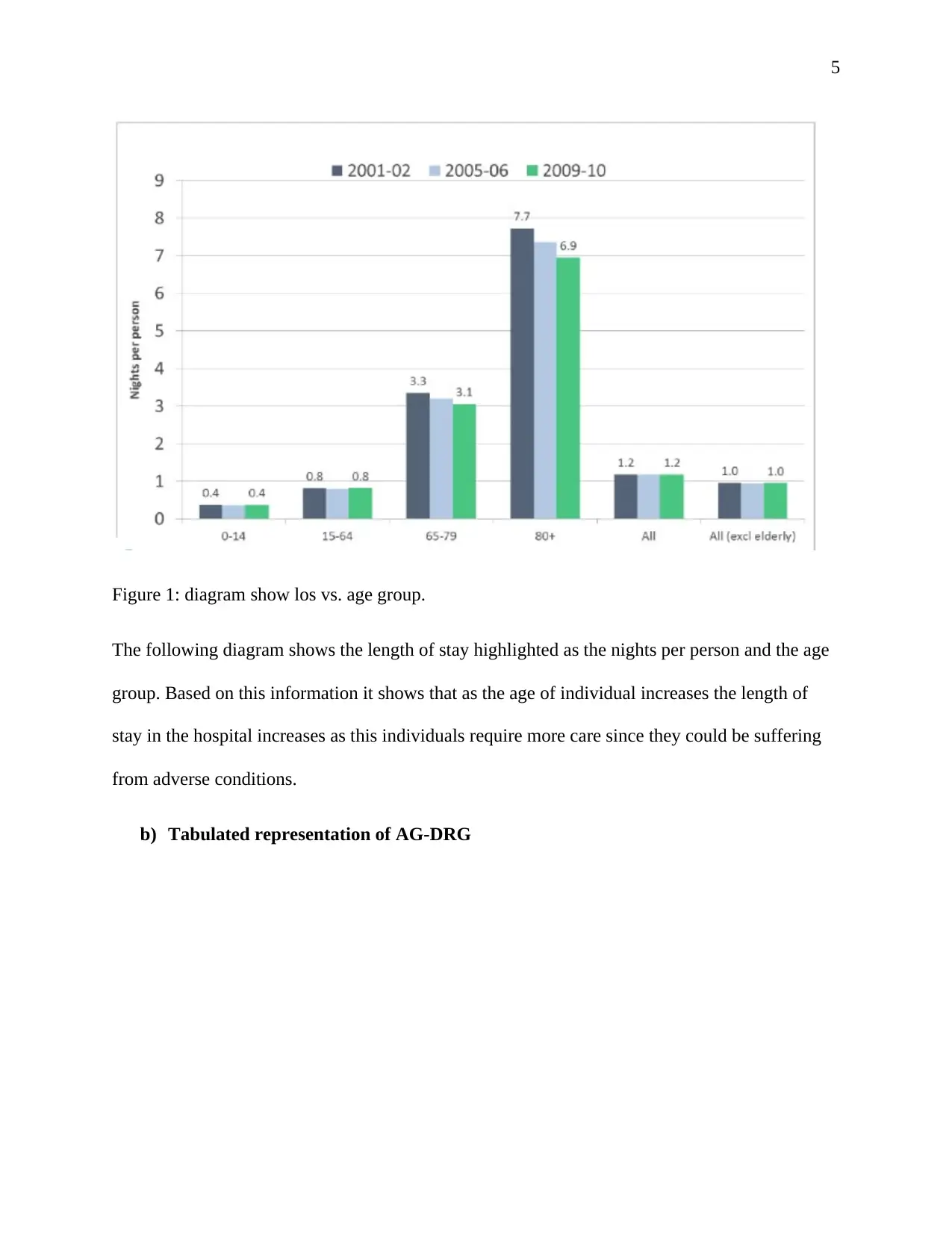
5
Figure 1: diagram show los vs. age group.
The following diagram shows the length of stay highlighted as the nights per person and the age
group. Based on this information it shows that as the age of individual increases the length of
stay in the hospital increases as this individuals require more care since they could be suffering
from adverse conditions.
b) Tabulated representation of AG-DRG
Figure 1: diagram show los vs. age group.
The following diagram shows the length of stay highlighted as the nights per person and the age
group. Based on this information it shows that as the age of individual increases the length of
stay in the hospital increases as this individuals require more care since they could be suffering
from adverse conditions.
b) Tabulated representation of AG-DRG
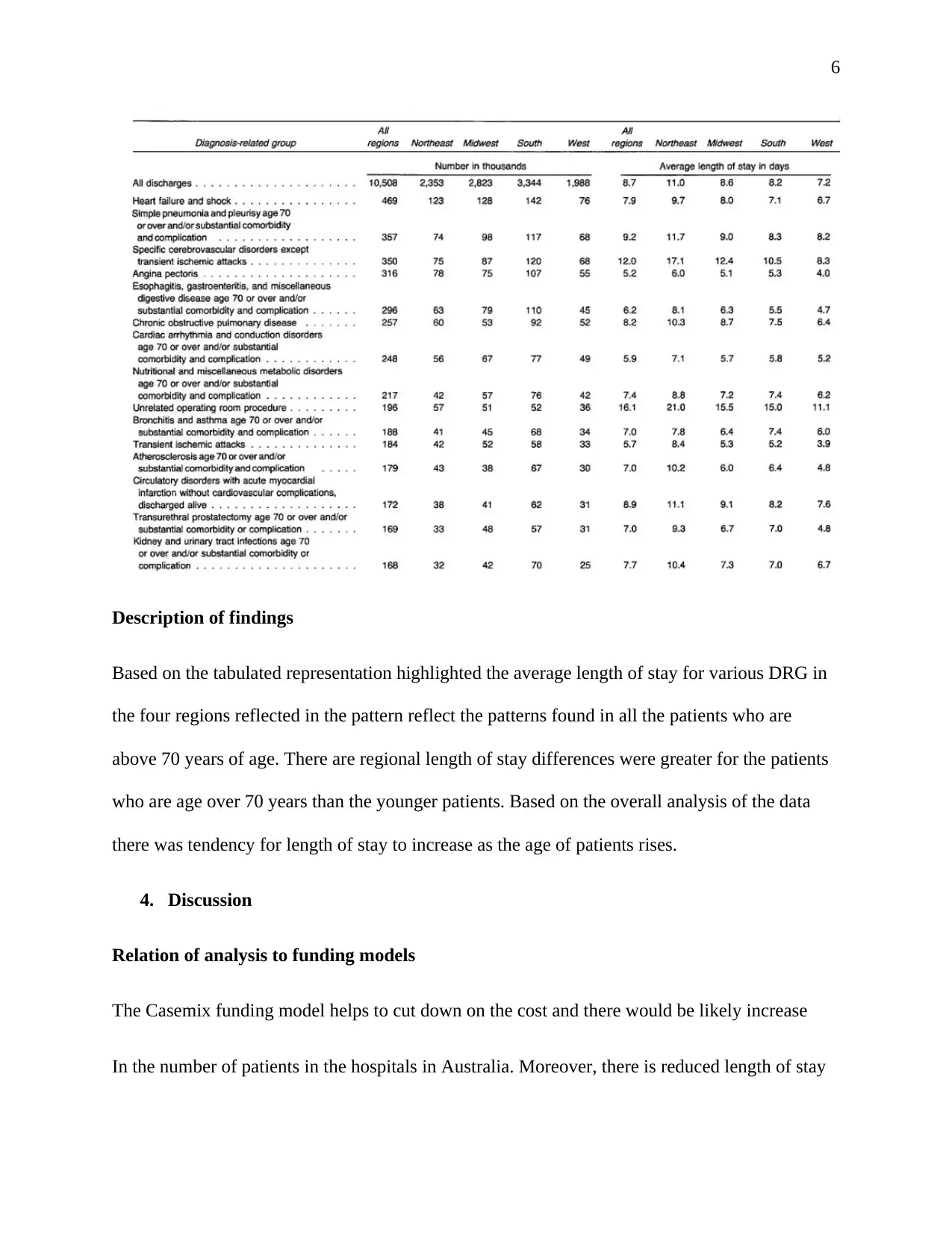
6
Description of findings
Based on the tabulated representation highlighted the average length of stay for various DRG in
the four regions reflected in the pattern reflect the patterns found in all the patients who are
above 70 years of age. There are regional length of stay differences were greater for the patients
who are age over 70 years than the younger patients. Based on the overall analysis of the data
there was tendency for length of stay to increase as the age of patients rises.
4. Discussion
Relation of analysis to funding models
The Casemix funding model helps to cut down on the cost and there would be likely increase
In the number of patients in the hospitals in Australia. Moreover, there is reduced length of stay
Description of findings
Based on the tabulated representation highlighted the average length of stay for various DRG in
the four regions reflected in the pattern reflect the patterns found in all the patients who are
above 70 years of age. There are regional length of stay differences were greater for the patients
who are age over 70 years than the younger patients. Based on the overall analysis of the data
there was tendency for length of stay to increase as the age of patients rises.
4. Discussion
Relation of analysis to funding models
The Casemix funding model helps to cut down on the cost and there would be likely increase
In the number of patients in the hospitals in Australia. Moreover, there is reduced length of stay
⊘ This is a preview!⊘
Do you want full access?
Subscribe today to unlock all pages.

Trusted by 1+ million students worldwide
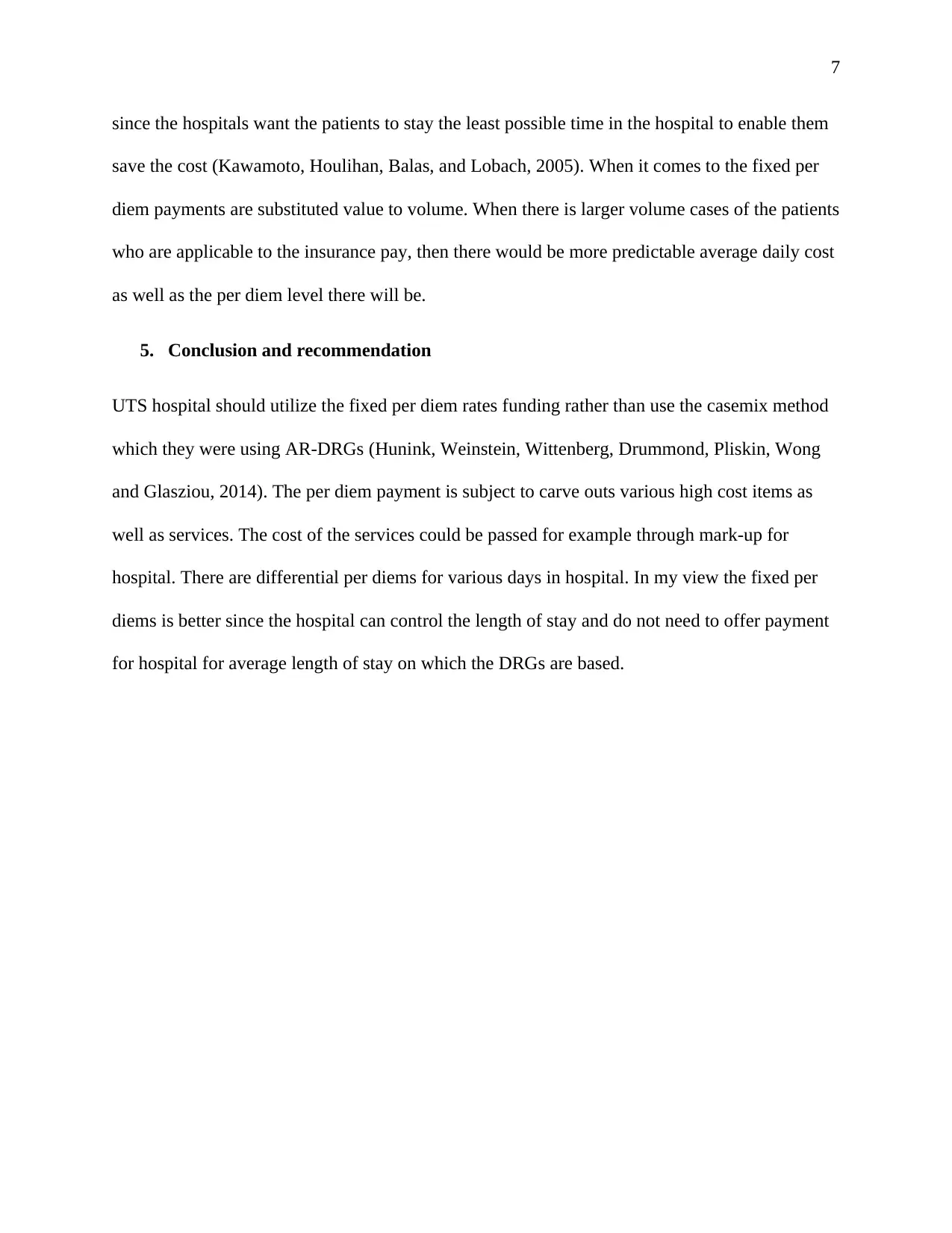
7
since the hospitals want the patients to stay the least possible time in the hospital to enable them
save the cost (Kawamoto, Houlihan, Balas, and Lobach, 2005). When it comes to the fixed per
diem payments are substituted value to volume. When there is larger volume cases of the patients
who are applicable to the insurance pay, then there would be more predictable average daily cost
as well as the per diem level there will be.
5. Conclusion and recommendation
UTS hospital should utilize the fixed per diem rates funding rather than use the casemix method
which they were using AR-DRGs (Hunink, Weinstein, Wittenberg, Drummond, Pliskin, Wong
and Glasziou, 2014). The per diem payment is subject to carve outs various high cost items as
well as services. The cost of the services could be passed for example through mark-up for
hospital. There are differential per diems for various days in hospital. In my view the fixed per
diems is better since the hospital can control the length of stay and do not need to offer payment
for hospital for average length of stay on which the DRGs are based.
since the hospitals want the patients to stay the least possible time in the hospital to enable them
save the cost (Kawamoto, Houlihan, Balas, and Lobach, 2005). When it comes to the fixed per
diem payments are substituted value to volume. When there is larger volume cases of the patients
who are applicable to the insurance pay, then there would be more predictable average daily cost
as well as the per diem level there will be.
5. Conclusion and recommendation
UTS hospital should utilize the fixed per diem rates funding rather than use the casemix method
which they were using AR-DRGs (Hunink, Weinstein, Wittenberg, Drummond, Pliskin, Wong
and Glasziou, 2014). The per diem payment is subject to carve outs various high cost items as
well as services. The cost of the services could be passed for example through mark-up for
hospital. There are differential per diems for various days in hospital. In my view the fixed per
diems is better since the hospital can control the length of stay and do not need to offer payment
for hospital for average length of stay on which the DRGs are based.
Paraphrase This Document
Need a fresh take? Get an instant paraphrase of this document with our AI Paraphraser
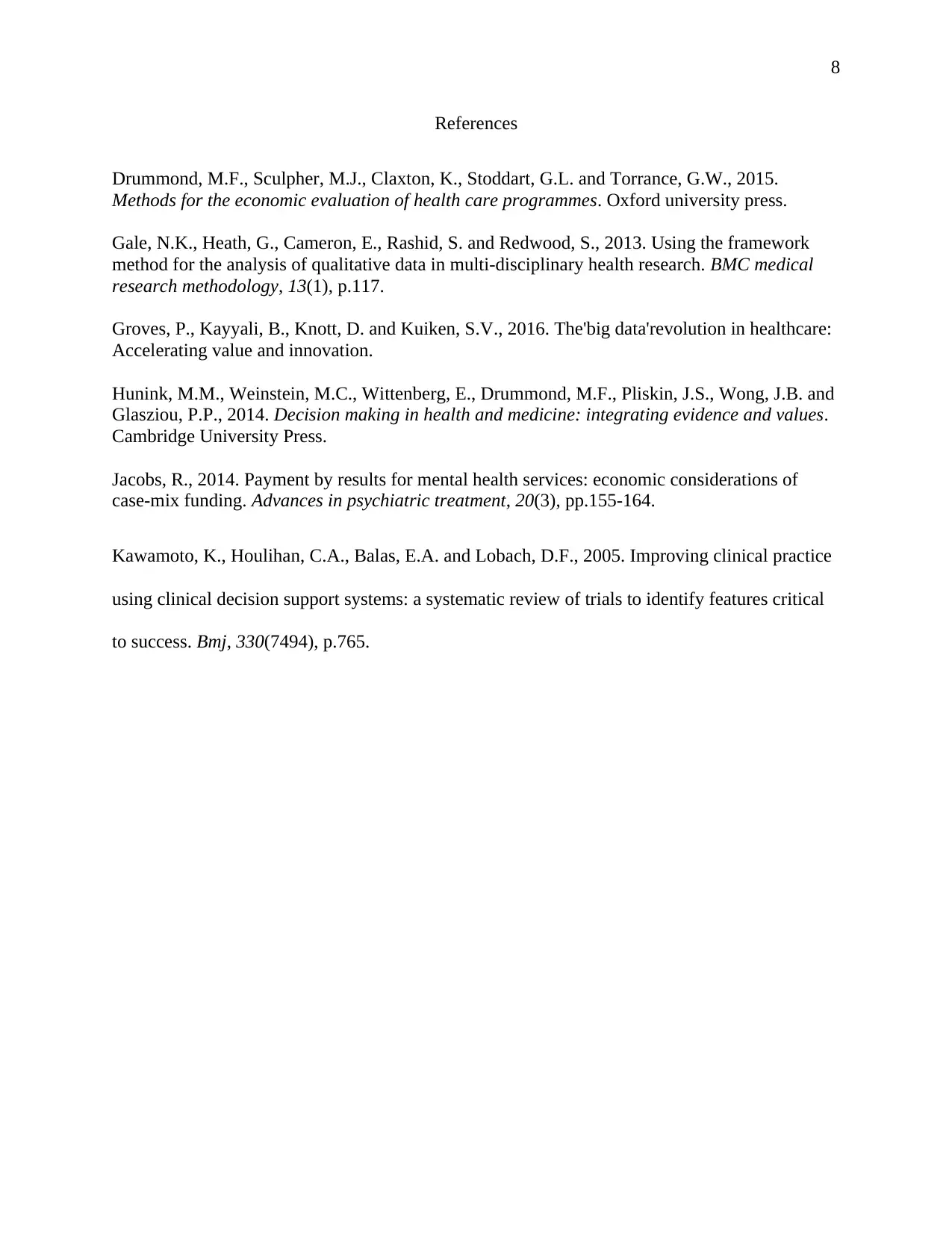
8
References
Drummond, M.F., Sculpher, M.J., Claxton, K., Stoddart, G.L. and Torrance, G.W., 2015.
Methods for the economic evaluation of health care programmes. Oxford university press.
Gale, N.K., Heath, G., Cameron, E., Rashid, S. and Redwood, S., 2013. Using the framework
method for the analysis of qualitative data in multi-disciplinary health research. BMC medical
research methodology, 13(1), p.117.
Groves, P., Kayyali, B., Knott, D. and Kuiken, S.V., 2016. The'big data'revolution in healthcare:
Accelerating value and innovation.
Hunink, M.M., Weinstein, M.C., Wittenberg, E., Drummond, M.F., Pliskin, J.S., Wong, J.B. and
Glasziou, P.P., 2014. Decision making in health and medicine: integrating evidence and values.
Cambridge University Press.
Jacobs, R., 2014. Payment by results for mental health services: economic considerations of
case-mix funding. Advances in psychiatric treatment, 20(3), pp.155-164.
Kawamoto, K., Houlihan, C.A., Balas, E.A. and Lobach, D.F., 2005. Improving clinical practice
using clinical decision support systems: a systematic review of trials to identify features critical
to success. Bmj, 330(7494), p.765.
References
Drummond, M.F., Sculpher, M.J., Claxton, K., Stoddart, G.L. and Torrance, G.W., 2015.
Methods for the economic evaluation of health care programmes. Oxford university press.
Gale, N.K., Heath, G., Cameron, E., Rashid, S. and Redwood, S., 2013. Using the framework
method for the analysis of qualitative data in multi-disciplinary health research. BMC medical
research methodology, 13(1), p.117.
Groves, P., Kayyali, B., Knott, D. and Kuiken, S.V., 2016. The'big data'revolution in healthcare:
Accelerating value and innovation.
Hunink, M.M., Weinstein, M.C., Wittenberg, E., Drummond, M.F., Pliskin, J.S., Wong, J.B. and
Glasziou, P.P., 2014. Decision making in health and medicine: integrating evidence and values.
Cambridge University Press.
Jacobs, R., 2014. Payment by results for mental health services: economic considerations of
case-mix funding. Advances in psychiatric treatment, 20(3), pp.155-164.
Kawamoto, K., Houlihan, C.A., Balas, E.A. and Lobach, D.F., 2005. Improving clinical practice
using clinical decision support systems: a systematic review of trials to identify features critical
to success. Bmj, 330(7494), p.765.
1 out of 8
Your All-in-One AI-Powered Toolkit for Academic Success.
+13062052269
info@desklib.com
Available 24*7 on WhatsApp / Email
![[object Object]](/_next/static/media/star-bottom.7253800d.svg)
Unlock your academic potential
Copyright © 2020–2025 A2Z Services. All Rights Reserved. Developed and managed by ZUCOL.


